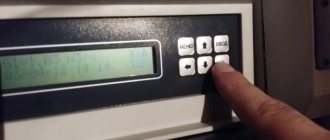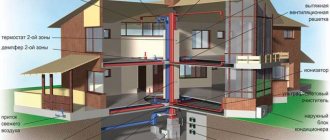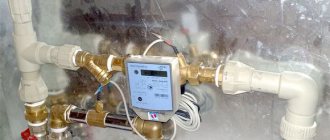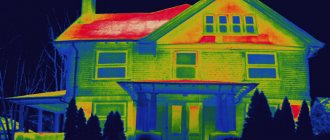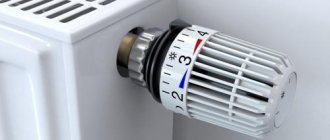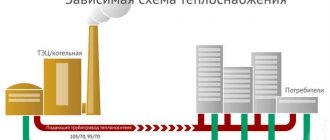Purpose of an apartment heating meter
Meters responsible for measuring the amount of heat are becoming increasingly popular. By installing such a device in your apartment, you will be able to control the consumption of thermal energy and, therefore, monitor how warm your home really is. Having such data, you can reduce costs and pay only for the heat received, and not for standard consumption rates.
Many users who doubt whether it is worth buying an apartment heat meter are wondering: how long will it take for such an acquisition to pay off?
Reviews from users who already have such devices indicate that installation costs are not very high, but savings will begin to be seen very soon. The tenant will not have to compensate for errors in the work of housing and communal services and heat loss in the system.
You can install either an individual heat meter for heating for an apartment or for an entire apartment building with central heating. There is a wide variety of models on the market today, differing in price and operating principle.
Stages of installation of thermal energy meters
The correct operation of the heat meter and the adequacy of its indicators depend on the type of devices and shut-off valves. Standard installation work is performed in the following sequence:
- Preparation. This includes: inspection of the installation site, development of a technical project. conditions, coordination of regulatory documentation with the heat energy supply organization. Extensive experience and many developments allow us to implement ready-made solutions with optimal use of heat meters, saving your time.
- Installation. Performed immediately after the completion of organizational activities. After successful commissioning, the UTE is handed over to the relevant heat supply organization.
Our engineers install thermal energy metering units, using certified, reliable devices that have excellent physical and operational characteristics. A guarantee is provided for the work performed, however, we recommend that you periodically request a service to check the correct operation of the equipment in order to identify malfunctions in a timely manner.
Types of heat meters in the heating system
There are four types of heat meters for apartments:
- mechanical;
- electromagnetic;
- vortex;
- ultrasonic.
Each of the devices has its own distinctive features. Let's look at each of them in detail.
Mechanical
This type is the simplest from a technical point of view and is inexpensive. The principle of its operation is that a special device rotates inside the device, through which the coolant moves and displays readings on a digital screen.
Mechanical meters are divided into:
- screw;
- turbine;
- winged.
Despite the fact that a mechanical counter is inexpensive, it cannot boast of a long service life. This is due to the fact that scale, rust and dirt contained in the water negatively affect the operation of the device. The situation can only be saved by installing water filters.
Electromagnetic
Such meters read readings using a current that appears at the moment when water passes through the magnetic field of the device. This type of counter has secured the title of a precision measuring device.
Heat meter TEM-104
However, it is worth taking into account that the presence of scale and other impurities in the water can significantly reduce the quality of its operation. It is also very important to approach the installation of electromagnetic meters responsibly, since the slightest defects will also affect the accuracy of the readings.
Vortex
These devices determine the amount of heating consumed through obstacles created by the movement of water or steam - vortices.
Such a device can be mounted on both vertical and horizontal wiring of the heating system.
The main characteristic feature is that it works excellently even with the presence of all kinds of deposits in the pipes. It also reacts to all kinds of impurities in water, air bubbles entering the coolant and welding.
When purchasing a vortex heat meter, be sure to consider the size of the pipeline in which this device will be installed.
Ultrasonic
Ultrasonic heat meter Pulse
Such devices are considered one of the most reliable and accurate measuring devices. Undoubtedly, the price of an ultrasonic meter is higher than other types.
The service life is affected only by the quality of the coolant. A prerequisite for installing such a device is a filter, because he will need clean water. If you neglect these simple requirements, you may end up with incorrect readings. Devices are divided into:
- temporary;
- frequency;
- Doppler;
- correlational.
Installation of heat meters in the apartment
It is not allowed to independently install a heat meter in an apartment. To do this, you need a whole package of permits and documents to carry out such work. Therefore, it is better to entrust the work to specialists.
The sequence of actions looks like this:
- Initially, you need to draw up an installation plan and coordinate it with the utility service.
- Then the meter is installed.
- After this, it needs to be registered.
- At the final stage, all that remains is to transfer the device under the supervision of the management company and put it into operation.
All meters have documents that record the time when the device needs to be checked. Typically the inspection is performed four times a year. After the time has passed, you should contact an organization that will test the meter.
These can be commercial companies, Rostest, manufacturing companies. If all residents of the house decide to check the heat meter and record heat, then they all together hire specialists who will install the device. Previously, at a general house meeting, issues related to cost are discussed.
In the case of installing an individual heat meter for an apartment, all actions related to the design and registration of the device are performed by the customer. Thus, having your own heat meter, you will be protected from malfunctions in the operation of a common household appliance.
When installing, you need to pay attention to the wiring system. This indicator can significantly affect how installation will be carried out and what the cost will be. In older buildings, vertical wiring is usually found, which means that there are several risers in the apartment. Installing a heat meter in each of them is not profitable from an economic point of view. It is better to install distributors responsible for fixing the temperature on the radiator and in the room by analyzing the heating efficiency.
In modern apartments, you can increasingly find a horizontal pipe distribution system, so installing one heat meter will be enough here. It is preferable to place it in the pipe itself through which the coolant circulates.
Pros and cons of a heat meter in an apartment
If you decide to install an individual heat meter in your apartment, then do not know that there will be no “super” savings, but it will allow you to save on heating within reason, reflecting the current consumption. Thanks to the meter, it is possible to monitor consumption when the unit is installed correctly and the thermostat controls the temperature. If you leave home, you can reduce the degrees and thus, at the end of the month, you can trace the positive dynamics of savings.
More information about thermostats for heating radiators can be found here
Only a reduction of 1 degree can save thermal energy up to 6%.
As already noted, in order to install such a device in your apartment, you need a list of documents:
- permission from the institution on whose balance sheet the house is located;
- technical requirements from the balance holder of the building supplying thermal energy;
- design design of the heat consumption unit, based on the parameters of the device, ready-made calculations also need to be checked against standard values;
- then installation is carried out according to the data of the finished project;
- then you need to conclude an agreement to the main contract with heat suppliers. It will record the amount of payment, which is based on the indicators of the individual meter;
- and finally, a certificate of completion of installation of the unit is drawn up with a representative of the organization that supplies heat, and the device is registered.
Advantages of using an apartment heat meter
If you decide to install a heat meter in your home, you must remember that this device itself will not give any result in terms of savings, but - within reason, of course - it will provide an opportunity to save on heating, demonstrating the current use of resources. You will soon see for yourself that this will have a positive impact on utility costs.
Note! The meter allows you to control energy consumption only when the temperature is controlled by a thermostat and the unit itself is designed correctly.
And if you lower the temperature every time you go to work, then at the end of the month you will be convinced that the purchase is worthwhile. So, according to preliminary calculations, the savings will be about 6 percent. It should also be remembered that the procedure for installing the meter itself is quite complicated - this will require the collection of appropriate documentation, and unforeseen expenses are also possible (we will tell you in more detail about the documents and installation a little later).
Manufacturers
Today, the market offers a large number of models of heat meters produced by different manufacturers. Let's look at the most popular ones.
Heat meter Elf
This Polish manufacturer has proven itself well in the market. The Elf apartment heating meter is a tachometer metering device with an electronic screen that allows you to simply read information about the amount of thermal energy consumed. The display shows the amount of heat consumed, inlet and return temperatures, temperature difference, current heat consumption and power.
Heat meter Elf-M
There are different models on sale with different nominal bores (DN 15-20), which are designed to control different volumes of coolant.
General technical characteristics for all models of this manufacturer are as follows:
- the temperature of the controlled coolant varies from +5 to +105°C;
- the minimum difference in the taken into account supply and return temperatures is 3°C, and can reach up to 100°C;
- the nominal value of coolant flow (based on the remote control and model) varies from 0.6 to 2.5 m³/hour;
- can be used in heating systems where the coolant pressure reaches 1.6 MPa;
- error in readings - no more than 2%;
- On average, such devices cost 10,000 rubles.
Elf meters can be installed in individual apartments and buildings, for heating of which a power of no more than 85 kW is sufficient.
Heat meter Karat
Such a device is produced by the URALTECHNOLOGY enterprise, and the Karat association is engaged in the sale of products.
Apartment heat meter KARAT-Compact 2
The Karat heat meter is made in the form of a monoblock, the lower base of which looks like a brass “bowl”, and the upper part is a compact electronic computer with a digital monochrome display, with the help of which the consumed thermal energy is recorded.
Two thermal converters extend from the computer itself: one is fixed in the flow part, the other is installed in the return pipeline.
Technical characteristics of individual heat meter Karat.
| Characteristic | Meaning | ||
| Temperature range of the computer, °C | 1 — 130 | ||
| Temperature range of the flow transducer, °C | 15 — 90 | ||
| Thermal converter type | Pt500 | ||
| Temperature range of the temperature sensor, °C | 0 — 130 | ||
| Diameter of the flow path, mm | 15 | 15 | 20 |
| Nominal flow, m³/hour | 0,6 | 1,5 | 2,5 |
| Maximum flow rate, m³/hour | 1,2 | 3,0 | 5,0 |
| Transition flow, m³/hour | 0,06 | 0,15 | 0,25 |
| Minimum flow rate, m³/hour | 0,024 | 0,06 | 0,1 |
| Sensitivity threshold, m³/hour | 0,004 | 0,004 | 0,006 |
| Maximum pressure, MPa | 1,6 | ||
| Battery life, years | at least 6 | ||
Installation of thermal energy metering units
The device records the actual consumption of hot water and heat energy in pipelines, and also monitors compliance with the standards of the amount of coolant received. For different heating systems, different types of meters, control cabinets and types of fittings are used, so the price of services may vary significantly.
The main condition for the implementation of the project is the proper installation of metering devices, which does not allow uncontrolled coolant consumption. That is why you need to trust this procedure to professionals - such as masters. They will help not only achieve maximum savings, but also ensure the correct functioning of all components of the system.
